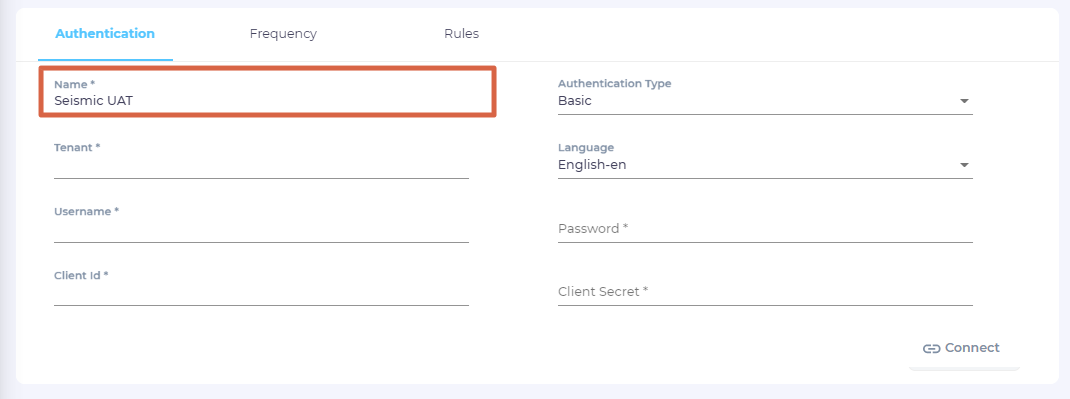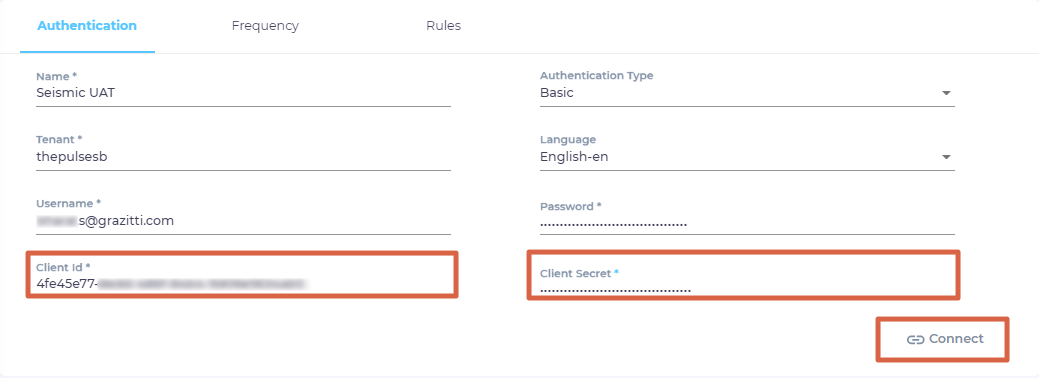Use Seismic Platform as a Content Source
This feature is not available in the SearchUnify Cloud Edition.
Make the sales enablement content stored in Seismic findable. SearchUnify's Seismic crawler can index Microsoft Word documents, PowerPoint presentations, PDFs, and practically all the files used for building MicroApps and LiveContent. It's then possible to link the indexed content to a search client on any supported platform. This article walks you through process of indexing.
PERMISSIONS
SearchUnify ignores user permissions during searches. All indexed files can be searched by all users.
Establish a Connection
- Find Seismic through the search box and click Add.
- Seismic data is stored as a content source, which requires a name. Give the data a relevant appellation in Name. For illustration, the content source has been named "Seismic UAT."
- As for now only Basic authorization is supported. Skip the Authorization tab.
- Data on Seismic is stored in DocCenter, which is accessible only through a Tenant ID. Enter the ID you use to access DocCenter in Tenant. For illustration, the tenant name is "thepulse".
- Skip Language if your documents are only in English. But if you have a multilingual sales collateral, then check all the languages from the dropdown.
- Enter User ID and password you use to log into Seismic in Username and Password respectively.
- SearchUnify indexes Seismic data through the official Seismic API. To use the API services, you are required to create an app. If you haven't already, create an app and enter the app ID and secret in Client ID and Client Secret respectively and click Connect.
If the linking is successful, then the Connect button changes to Connected and Password and Client Secret fields turn blank.
Re-Connect
An admin can edit a Content Source for multiple reasons, including:
-
To reauthenticate
-
To fix a crawl error
-
To change frequency
-
To add or remove an object or a field for crawling
When a Content Source is edited, either a Connect or a Re-Connect button is displayed.
-
Case 1: When the Connect button is displayed:
-
When the Connect button is displayed if the Content Source authentication is successful. Along with the button, a message is displayed There are no crawl errors and the Content Source authentication is valid.
-
Fig. The Connect button is displayed on the Authentication tab.
-
Case 2: When the Re-connect button is displayed:
-
The Re-connect button is displayed when the authentication details change or the authentication fails for any reason.
-
In both cases, the Content Source connection must be authenticated again. To reauthenticate a Content Source, enter the authentication details, and click Re-Connect.
-
Fig. The Re-Connect button is displayed on the Authentication tab.
Set Up Crawl Frequency
The first crawl is always performed manually after configuring the content source. In the Choose a Date field, select a date to start the crawl; only data created after the selected date will be crawled*. For now, leave the frequency set to its default value, Never, and click Set.
Fig. The Frequency tab when "Frequency" is set to "Never".
Select Fields for Indexing
SearchUnify currently indexes one Seismic content object, documents. In documents, you can specify any (or all) of the supported fields for indexing: id, name, version, modifiedAt, latestLibraryContentVersionId, latestLibraryContentVersionSize, libraryUrl, docCenterUrl, format, teamsiteId, isDeleted, ownerId, isPublished, post_time, and viewHref. For example, if id is indexed, then you can look up a document through its ID or if format is indexed then you can use PDF, DOC, and other format field values as filter. The latter comes in handy when you are looking for sales enablement content in a particular format.
-
To specify fields for indexing, click
 .
. -
Delete the fields you don't want to index and click Apply. Pro Tip: It's recommended not to delete any field for a better search experience.
-
Click Save.
Find and Replace
Users on the Q2 '24 release or a later version will notice a new button next to each object on the Rules screen. It resembles a magnifying glass and is labeled "Find and Replace." You can use this feature to find and replace values in a single field or across all fields. The changes will occur in the search index and not in your content source.
Fig. The "Find and Replace" button on the Rules tab in the Actions column.
Find and Replace proves valuable in various scenarios. A common use case is when a product name is altered. Suppose your product name has changed from "SearchUnify" to "SUnify," and you wish for the search result titles to immediately reflect this change.
-
To make the change, click
 .
. -
Now, choose either "All" or a specific content source field from the "Enter Name" dropdown. When "All" is selected, any value in the "Find" column is replaced with the corresponding value in the "Replace" column across all content source fields. If a particular field is chosen, the old value is replaced with the new value solely within the selected field.
-
Enter the value to be replaced in the Find column and the new value in the Replace column. Both columns accept regular expressions.
Fig. Snapshot of Find and Replace.
-
Click Add. You will see a warning if you are replacing a value in all fields.
-
Click Save to apply settings
-
Run a crawl for the updated values to reflect in the search results.
After the First Crawl
Return to the Content Sources screen and click ![]() in Actions. The number of indexed documents is updated after the crawl is complete. You can view crawl progress by clicking
in Actions. The number of indexed documents is updated after the crawl is complete. You can view crawl progress by clicking ![]() (View Crawl Logs) in Actions.
(View Crawl Logs) in Actions.
Once the first crawl is complete, click ![]() in Actions to open the content source for editing, and set a crawl frequency.
in Actions to open the content source for editing, and set a crawl frequency.
-
In Choose a Date, click
 to fire up a calendar and select a date. Only the data created or updated after the selected date is indexed.
to fire up a calendar and select a date. Only the data created or updated after the selected date is indexed. -
The following options are available for the Frequency field:
-
When Never is selected, the content source is not crawled until an admin opts for a manual crawl on the Content Sources screen.
-
When Minutes is selected, a new dropdown appears where the admin can choose between three values: 15, 20, and 30. Picking 20 means that the content source crawling starts every 20 minutes.
-
When Hours is selected, a new dropdown is displayed where the admin can choose between eight values between 1, 2, 3, 4, 6, 8, 12, and 24. Selecting 8 initiates content crawling every 8 hours.
-
When Daily is selected, a new dropdown is displayed where the admin can pick a value between 0 and 23. If 15 is selected, the content source crawling starts at 3:00 p.m. (1500 hours) each day.
-
When Day of Week is selected, a new dropdown is displayed where the admin can pick a day of the week. If Tuesday is chosen, then content source crawling starts at 0000 hours on every Tuesday.
-
When Day of Month is selected, a new dropdown appears where the admin can select a value between 1 and 30. If 20 is chosen, then content source crawling starts on the 20th of each month.
It is recommended to pick a date between the 1st and 28th of the month. If 30 is chosen, then the crawler may throw an error in February. The error will be “Chosen date will not work for this month.”
-
When Yearly is selected, the content source crawling starts at midnight on 1 January each year.
Fig. The content source crawling starts at 00:00 on each Tuesday.
-
- Click Set to save the crawl frequency settings.
-
Click Save.





















